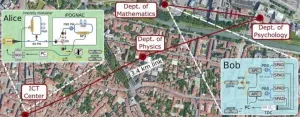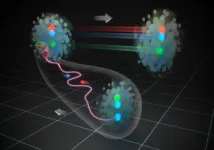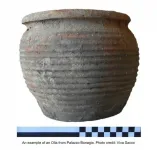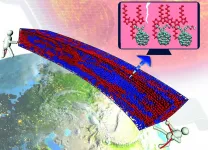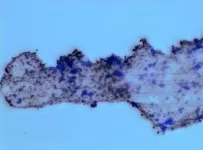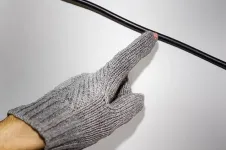(Press-News.org) WASHINGTON -- In a new study, researchers demonstrate an automated, easy-to-operate quantum key distribution (QKD) system using the fiber network in the city of Padua, Italy. The field test represents an important step toward implementing this highly secure quantum communication technology using the type of communication networks already in place in many regions around the world.
QKD offers impenetrable encryption for data communication because it uses the quantum properties of light to generate secure random keys for encrypting and decrypting data.
"QKD can be useful in any situation where security is paramount because it offers unconditional security for the key exchange process," said Marco Avesani from Università degli Studi di Padova in Italy, co-first author of the new study with Luca Calderaro and Giulio Foletto. "It can be used to encrypt and authenticate health data sent between hospitals or money transfers among banks, for example."
In The Optical Society (OSA) journal Optics Letters, researchers led by Paolo Villoresi and Giuseppe Vallone report that their simple system is stable over time and can generate quantum-secure cryptographic keys at sustained rates over a standard telecommunications infrastructure.
"QKD systems usually require a complex stabilization system and additional dedicated synchronization hardware," said Avesani. "We developed a complete QKD system that can be
directly interfaced with standard telecommunications equipment and doesn't require additional hardware for synchronization. The system fits easily into the rack enclosures commonly found in server rooms."
Designing an easy-to-use system
To produce the quantum states required by QKD, the researchers developed a new encoder for manipulating the polarization of single photons. The encoder, which the researchers call iPOGNAC, provides a fixed and stable polarization reference that doesn't require frequent recalibration. This feature is also advantageous for free-space and satellite quantum communication, where recalibrations are hard to perform.
"Because of the technology we developed, the source was ready to produce quantum states when we moved our system from the lab to the location of the field trial," said Calderaro. "We didn't have to perform the slow, and often prone-to-failure, alignment procedure required for most QKD systems."
The researchers also developed a new synchronization algorithm, which they call
Qubit4Sync, to synchronize the machines of the two QKD users. Rather than using dedicated additional hardware and an added frequency channel for synchronization, the new system uses software and the same optical signals being used for QKD. This makes the system smaller, cheaper, and easier to integrate into an existing optical network.
To test the new system, the researchers brought their two QKD terminals to two university buildings roughly 3.4 km apart in different sections of Padua. They connected the systems to two underground optical fibers that are part of the university's communication network. These fibers supported the quantum channel carrying qubits and the classical channel needed to transfer ancillary information.
A quantum-secured video call
"The field trial was successful," said Foletto. "We showed that our simple system can produce secret keys at speeds of kilobits per second and that it works outside of the laboratory with little human intervention. It was also easy and quick to install."
In a public demonstration, the researchers used their setup to enable a quantum-secured video call between the Rector of the University of Padua and the Director of the Mathematics Department. The researchers note that the system's performance is comparable to other commercial QKD systems in terms of secret key generation rate while also having fewer components and being easier to integrate into an existing fiber network.
They are working to reduce the size of the detection apparatus and to make the system more robust to noise from other light traveling in the same fiber. The effort to develop a complete and autonomous QKD system led to the creation of a spin-off company called ThinkQuantum s.r.l, which is working to commercialize this technology.
INFORMATION:
Paper: M Avesani, L. Calderaro, G. Foletto, C. Agnesi, F. Picciariello, F. Santagiustina, A. Scriminich, A. Stanco, F. Vedovato, M. Zahidy, G. Vallone, P. Villoresi, "Resource-effective Quantum Key Distribution: a field trial in Padua city center," Opt. Lett., 46, 12, 2848-2851(2021).
DOI: https://doi.org/10.1364/OL.422890.
About Optics Letters
Optics Letters offers rapid dissemination of new results in all areas of optical science with short, original, peer-reviewed communications. Optics Letters accepts papers that are noteworthy to a substantial part of the optics community. Published by The Optical Society and led by Editor-in-Chief Miguel Alonso, Institut Fresnel, École Centrale de Marseille and Aix-Marseille Université, France, University of Rochester, USA. Optics Letters is available online at OSA Publishing.
About The Optical Society
Founded in 1916, The Optical Society (OSA) is the leading professional organization for scientists, engineers, students and business leaders who fuel discoveries, shape real-life applications and accelerate achievements in the science of light. Through world-renowned publications, meetings and membership initiatives, OSA provides quality research, inspired interactions and dedicated resources for its extensive global network of optics and photonics experts. For more information, visit osa.org.
Media Contact:
mediarelations@osa.org
Two gene variants found in African American women may explain why they are more likely to be diagnosed with triple negative breast cancer (TNBC) than white women of European ancestry, according to Weill Cornell Medicine and NewYork-Presbyterian investigators. The study findings may have implications for developing better risk assessment tools for TNBC in African American women and for understanding why they have poorer TNBC outcomes.
In a study, published April 29 in Scientific Reports, the investigators found that a version of the ANKLE1 gene that can be protective against TNBC is less likely to be found in African American women than white women of European ancestry. In addition, African American women with a mutation in the Duffy gene, which plays a role in inflammation, ...
Inside each proton or neutron there are three quarks bound by gluons. Until now, it has often been assumed that two of them form a "stable" pair known as a diquark. It seems, however, that it's the end of the road for the diquarks in physics. This is one of the conclusions of the new model of proton-proton or proton-nucleus collisions, which takes into account the interactions of gluons with the sea of virtual quarks and antiquarks.
In physics, the emergence of a new theoretical model often augurs badly for old concepts. This is also the case with the description of collisions of protons with protons or atomic nuclei, proposed by scientists from the Institute of Nuclear Physics of the Polish Academy of Sciences (IFJ PAN) ...
Organic residues on ceramic pottery are a valuable resource for understanding medieval cuisines of Islamic-ruled Sicily, according to a study published June 9, 2021 in the open-access journal PLOS ONE by Jasmine Lundy of the University of York, UK and colleagues.
During the 9th to 12th century AD, Sicily was under Islamic rule. This transition is known to have profoundly impacted the region, and the capital city of Palermo thrived as an economic and cultural center of the Mediterranean Islamic world. But little is known about how the lives of people in the region were impacted during this important time period.
In this study, researchers examined organic residues of plant and animal products on ceramic pottery to gain insights ...
Today, solar energy provides 2% of U.S. power. However, by 2050, renewables are predicted to be the most used energy source (surpassing petroleum and other liquids, natural gas, and coal) and solar will overtake wind as the leading source of renewable power. To reach that point, and to make solar power more affordable, solar technologies still require a number of breakthroughs. One is the ability to more efficiently transform photons of light from the Sun into useable energy.Organic photovoltaics max out at 15% to 20% efficiency -- substantial, but a limit on solar energy's potential. Lehigh University engineer Ganesh Balasubramanian, like many others, wondered if there were ways to improve the design of solar cells to make them more ...
GRAND RAPIDS, Mich. (JUNE 8, 2021) -- Chronic inflammation in the gut may propel processes in the body that give rise to Parkinson's disease, according to a study by scientists at Van Andel Institute and Roche.
The study, published in Free Neuropathology, is the latest in a growing list that links the gut and the immune system to Parkinson's. The researchers' findings in an experimental mouse model of gut inflammation track with several large-scale epidemiological studies that show an association between Parkinson's and inflammatory bowel diseases, such as ulcerative colitis and Crohn's disease.
Epidemiological evidence from other groups indicates the risk of developing Parkinson's fades in certain people whose ...
Small pieces of plastic are everywhere, stretching from urban environments to pristine wilderness. Left to their own devices, it can take hundreds of years for them to degrade completely. Catalysts activated by sunlight could speed up the process, but getting these compounds to interact with microplastics is difficult. In a proof-of-concept study, researchers reporting in ACS Applied Materials & Interfaces developed self-propelled microrobots that can swim, attach to plastics and break them down.
While plastic products are omnipresent indoors, plastic waste and broken bits now litter the outdoors, too. The smallest of these ...
TORONTO, June 9, 2021 - Researchers from York University and the University of British Columbia have found social media use to be one of the factors related to the spread of COVID-19 within dozens of countries during the early stages of the pandemic.
The researchers say this finding resembles other examples of social media misinformation ranging from the initial phase of vaccine rollout to the 2021 Capitol riot in the United States.
Countries with high social media use leading to off-line political action prior to the pandemic, as surveyed before the pandemic by V-Dem (a database from the University of Gothenburg), showed ...
Skoltech researchers and their colleagues from RAS Institute for Physics of Microstructures, Lobachevsky State University of Nizhny Novgorod, ITMO University, Lomonosov Moscow State University, and A.M. Prokhorov General Physics Institute have found a way to increase photoluminescence in silicon, the notoriously poor emitter and absorber of photons at the heart of all modern electronics. This discovery may pave the way to photonic integrated circuits, boosting their performance. The paper was published in the journal Laser and Photonics Reviews.
"Natural selection" in semiconductor technology ...
Vertebrate life began in the water, but around 340-360 million years ago, four-limbed creatures, or tetrapods, made the transition onto land. In the years that followed, some species adapted to terrestrial life, while others turned back to the water and readapted to an aquatic lifestyle.
A new study of these early amphibians, published in the journal PLOS ONE and led by Penn paleontologist Aja Carter, suggests that these environmental shifts left an impression--on the shape of the animals' spines.
"I'm interested in how the shapes of the vertebrae affect how animals move," she says. "Our findings suggest that, in at least one part of the vertebrae, the shape of the bones ...
WEST LAFAYETTE, Ind. - Purdue University engineers have developed a method to transform existing cloth items into battery-free wearables resistant to laundry. These smart clothes are powered wirelessly through a flexible, silk-based coil sewn on the textile.
In the near future, all your clothes will become smart. These smart cloths will outperform conventional passive garments, thanks to their miniaturized electronic circuits and sensors, which will allow you to seamlessly communicate with your phone, computer, car and other machines. This smart clothing will not only make you more productive but also check on your health status and even call for help if you suffer an accident. The reason why this smart clothing ...
